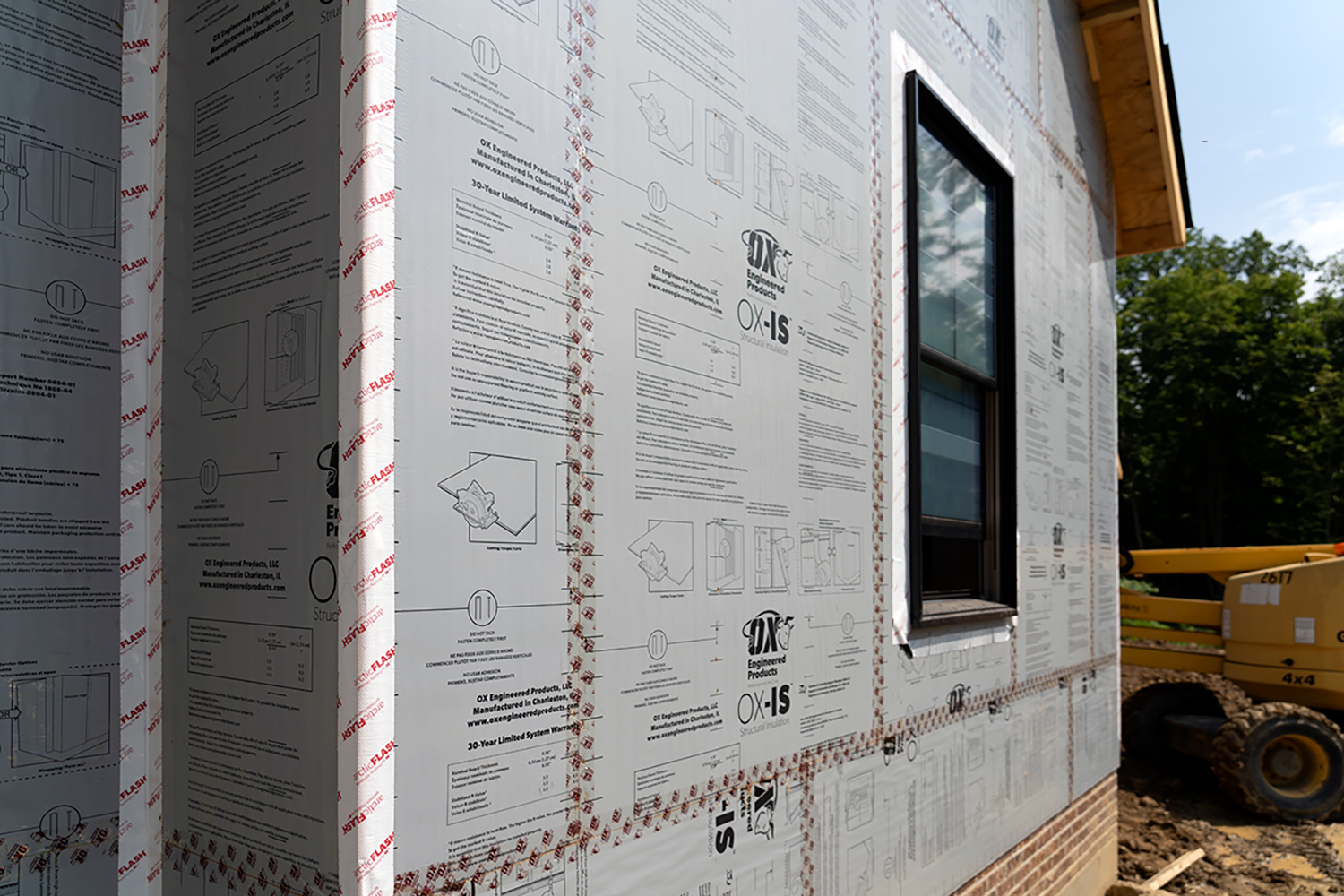For any construction project in the 21st century, achieving energy-efficiency is a prime directive. Among the arsenal of tools available to builders charged with constructing exterior walls, insulated sheathing stands out as a key component in enhancing overall thermal performance. These integrated materials, such as the innovative solutions offered by OX Engineered Products, play a vital role in optimizing energy efficiency, providing structural strength, and enhancing comfort levels for occupants inside of multifamily dwellings.
Total Thermal Performance
Insulated sheathing is designed to enhance the performance of a building’s thermal envelope while adding structural strength. By providing an additional layer of continuous insulation on the outside of the exterior walls, it helps reduce thermal bridging, which occurs when heat is transferred through materials with higher conductivity, such as wood studs or metal framing. This results in more consistent indoor temperatures, reduced heat loss in winter, and minimized heat gain in summer. When installed with the proper seam tapes and used in conjunction with thermally efficient windows and doors, the material can significantly bolster a building’s overall energy efficiency.
Furthermore, integrated insulated sheathing materials can serve as a moisture barrier as well, protecting the building from water infiltration and condensation. This not only improves the long-term durability of the structure but also enhances indoor air quality by preventing mold and mildew growth.
In addition to its thermal and moisture benefits, insulated sheathing – when installed continuously and properly – contributes to the overall air tightness of a building envelope. This air sealing effect helps reduce the infiltration of outside air, preventing energy loss associated with unwanted drafts. When combined with other energy-efficient building practices, such as the proper sealing of joints and penetrations, insulated sheathing can play a pivotal role in achieving a high-performance building envelope that meets or exceeds energy code requirements.
These materials specifically help meet the 2021 International Energy Conservation Codes and can assist builders and owners in achieving significant federal rebates such as the 45L tax credits, which apply to both single-family and multifamily construction.
Integrated Solutions: The OX-IS Advantage
A prime example of a high-performance integrated material is OX Engineered Products' OX-IS insulated sheathing system. While OX-IS offers exceptional thermal insulation, its benefits go beyond just enhancing R-values. The system is designed to bolster the performance of the overall building envelope, contributing to improved energy efficiency, indoor comfort, and the health of the structure.

Moreover, OX-IS is easy to install, reducing construction time and labor costs. Its lightweight nature makes it ideal for a wide range of applications, from residential to multifamily and commercial buildings. Additionally, OX-IS is an environmentally friendly material made with more than 70% post-consumer recycled materials, contributing to greener structures.
See the Stats
According to a study by the Department of Energy, buildings account for approximately 40% of total U.S. energy consumption. By incorporating insulated sheathing, builders can do their part to help reduce this figure. The energy efficiency of the built environment is crucial to achieving global sustainability goals, and selecting the right products can have a big impact.
On a micro scale, per individual structure, products such as OX-IS can reduce ACH50 blower door test results by 15 to 20 percent, some homes and buildings even greatly exceeding this number. In addition, the 4-in-1 insulated sheathing material has proven to reduce heating and cooling costs by anywhere from 20 to 40 percent, allowing owners to choose downsized HVAC systems when outfitting a multifamily building with new units. This, in itself, can save owners big. Finally, when compared to using uninsulated OSB, 1-inch OX-IS delivers a 1,100% increase in R-value for the structure.
Ultimately, selecting insulated sheathing materials leads to substantial energy savings over the life of a building and helps to create a reduced carbon footprint.
Building Better
Insulated sheathing plays a crucial role in improving the thermal performance of multifamily buildings. To meet the most stringent code requirements set by the International Code Council, many builders are using insulated sheathing in conjunction with standard batt or spray foam for even greater thermal performance.
Integrated products such as OX-IS are helping builders nationwide meet these rising energy demands, while giving a much-needed boost to a building’s air and moisture resistance.
By leveraging these innovative, integrated products, the industry can continue to create sustainable structures that meet the evolving demands of modern construction.
Related Stories
Affordable Housing | May 30, 2024
General contractor’s keys to a successful affordable housing project
General contractors can have tremendous influence over a project’s success in terms of schedule, budget, and quality. However, to ensure a project is put on this path, there are a few factors that must be considered.
MFPRO+ New Projects | May 29, 2024
Two San Francisco multifamily high rises install onsite water recycling systems
Two high-rise apartment buildings in San Francisco have installed onsite water recycling systems that will reuse a total of 3.9 million gallons of wastewater annually. The recycled water will be used for toilet flushing, cooling towers, and landscape irrigation to significantly reduce water usage in both buildings.
MFPRO+ News | May 28, 2024
ENERGY STAR NextGen Certification for New Homes and Apartments launched
The U.S. Environmental Protection Agency recently launched ENERGY STAR NextGen Certified Homes and Apartments, a voluntary certification program for new residential buildings. The program will increase national energy and emissions savings by accelerating the building industry’s adoption of advanced, energy-efficient technologies, according to an EPA news release.
Student Housing | May 28, 2024
Student housing remains strong in May 2024
Although the pace has slowed down this year, student housing preleasing for the 2024–2025 season reached 73.5% in April, 50 basis points year-over-year (YOY).
MFPRO+ News | May 24, 2024
Austin, Texas, outlaws windowless bedrooms
Austin, Texas will no longer allow developers to build windowless bedrooms. For at least two decades, the city had permitted developers to build thousands of windowless bedrooms.
Mass Timber | May 22, 2024
3 mass timber architecture innovations
As mass timber construction evolves from the first decade of projects, we're finding an increasing variety of mass timber solutions. Here are three primary examples.
Mixed-Use | May 22, 2024
Multifamily properties above ground-floor grocers continue to see positive rental premiums
Optimizing land usage is becoming an even bigger priority for developers. In some city centers, many large grocery stores sprawl across valuable land.
MFPRO+ News | May 21, 2024
Massachusetts governor launches advocacy group to push for more housing
Massachusetts’ Gov. Maura Healey and Lt. Gov. Kim Driscoll have taken the unusual step of setting up a nonprofit to advocate for pro-housing efforts at the local level. One Commonwealth Inc., will work to provide political and financial support for local housing initiatives, a key pillar of the governor’s agenda.
MFPRO+ News | May 21, 2024
Baker Barrios Architects announces new leadership roles for multifamily, healthcare design
Baker Barrios Architects announced two new additions to its leadership: Chris Powers, RA, AIA, NCARB, EDAC, as Associate Principal and Director (Healthcare); and Mark Kluemper, AIA, NCARB, as Associate Principal and Technical Director (Multifamily).
MFPRO+ News | May 20, 2024
Florida condo market roiled by structural safety standards law
A Florida law enacted after the Surfside condo tower collapse is causing turmoil in the condominium market. The law, which requires buildings to meet certain structural safety standards, is forcing condo associations to assess hefty fees to make repairs on older properties. In some cases, the cost per unit runs into six figures.

















